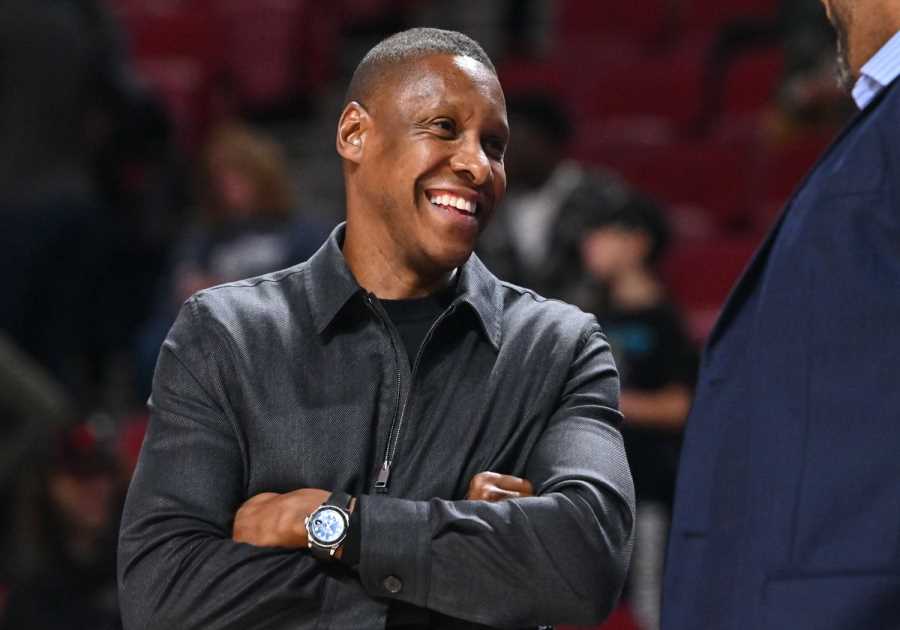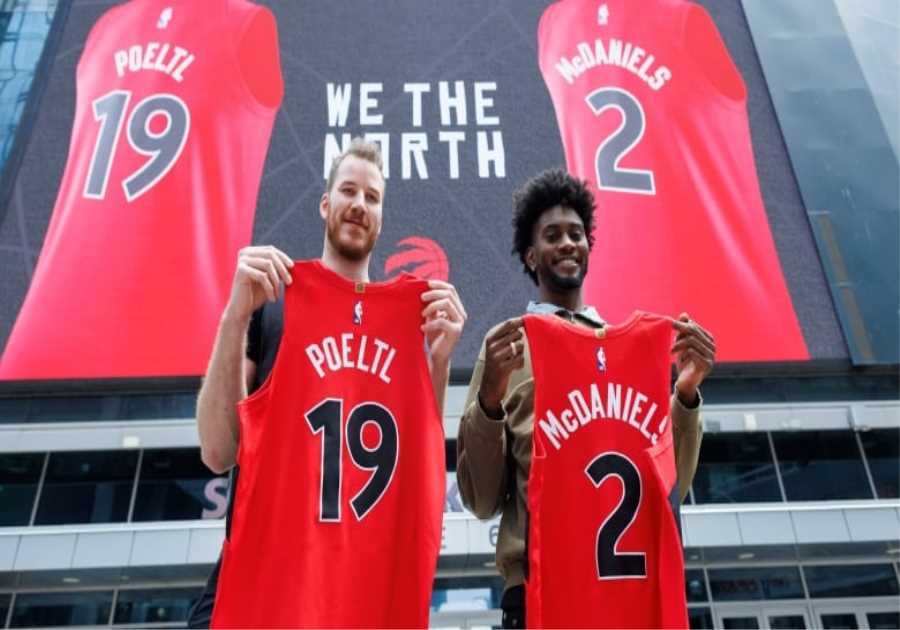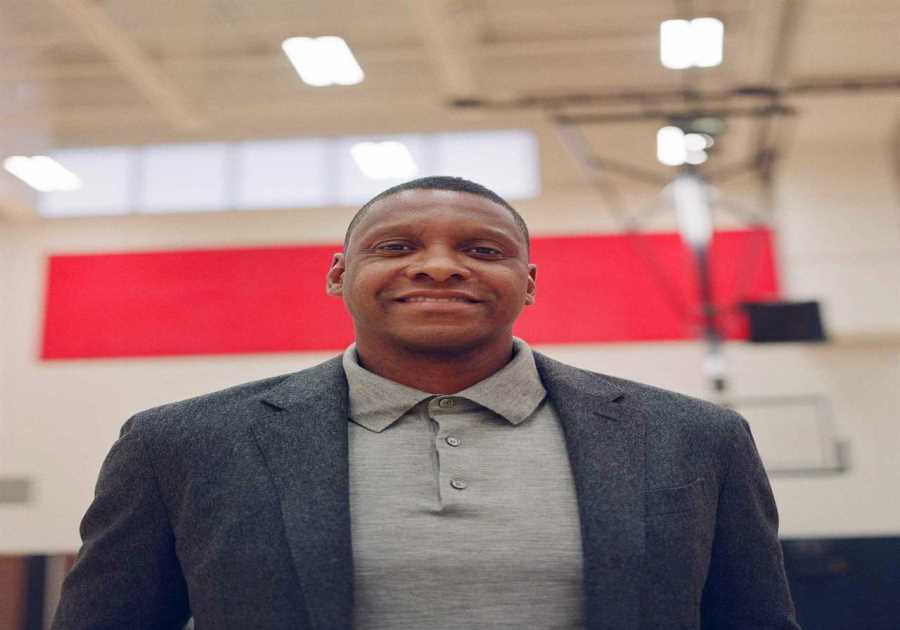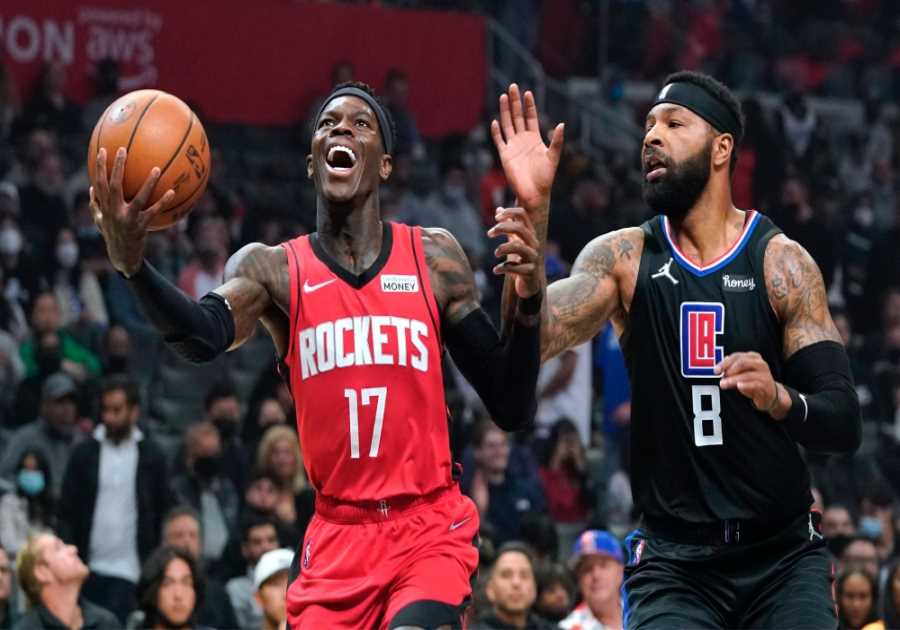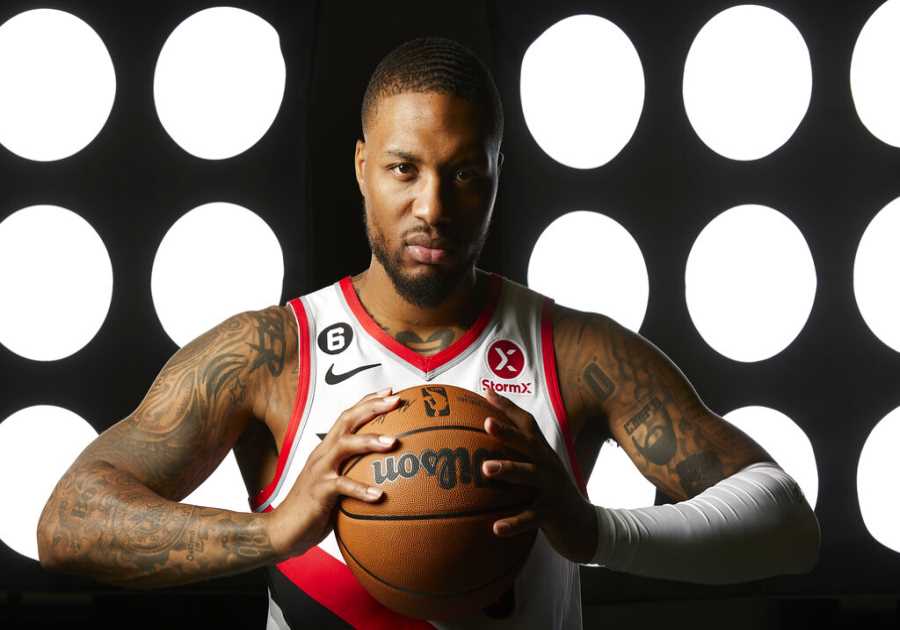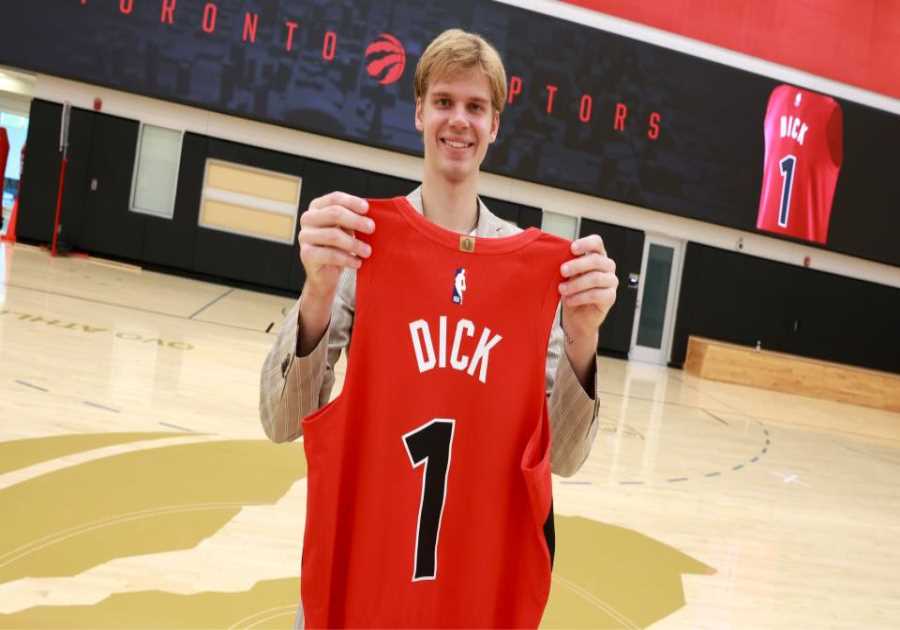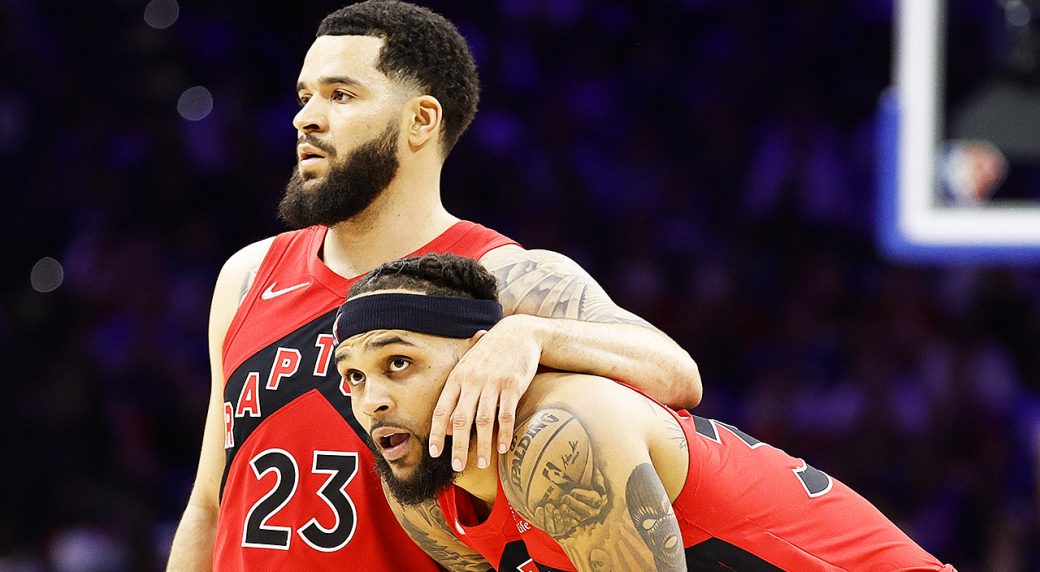
Patience isn’t free.
The Toronto Raptors didn’t stand pat entirely at the NBA trade deadline on Thursday. Instead, they paid a price to delay some bigger-picture decisions about the upside of their current core and the ultimate direction of the franchise in the medium-term.
That decision is justifiable — NBA executives found the Raptors so intriguing ahead of the deadline in large part because there wasn’t a single “right” answer in their situation — but the simple act of not acting carries risk. Everything has a cost, whether it be time, opportunity, or leverage.
There are scenarios in which the Raptors revisit trade talks in the summer and are able to recoup at least some of the value they could have at the deadline. (I’m skeptical it would be equivalent.) There are scenarios in which things click and the front office decides to run this newly-reinforced core back for another year. There are doomsday scenarios that wipe the spreadsheets clean, as there always are.
Whatever path the Raptors take, the cost of making that decision in July instead of here in February is clear: They’ve made a two-footed jump into the precarious Bird Rights Trap.
Let’s reset for the remainder of this year and the summer ahead.
The terms
Raptors receive: Jakob Poeltl
Spurs receive: Khem Birch, a top-six protected 2024 first-round draft pick, and two second-round picks
The picks
The Raptors are betting on themselves to some degree here, with limited protection. The 2024 first-rounder they traded is only protected for the top six selections in the NBA Draft. That means that the Raptors will send San Antonio the pick if it lands anywhere from No. 7 to 30. The Raptors will only keep their pick if they’re extremely bad or are moderately bad and get some lottery luck.
That pick rolls over into a 2025 first-round pick if it doesn’t convey in 2024, and a 2026 first-round pick if it doesn’t convey in 2025. It seems fairly unlikely the Raptors would pick in the top six three consecutive seasons, but if they do, the Spurs would instead receive second-round picks in 2026 and 2027.
An important note: Because you can’t trade future first-round picks in consecutive years, and the Raptors’ pick owed to the Spurs may be conveyed in 2024, 2025, or 2026, the earliest first-round pick the Raptors can currently trade is their 2028 pick. You can get out of that by removing the top-six protection on the pick, or once the pick actually changes hands in 2024. For now, the Raptors can’t trade their 2023-2027 firsts just in case.
Essentially, the Raptors are betting they’ll be good enough soon enough that the first-rounder they gave up was a pick in the teens or 20s in a weaker 2024 draft.
The second-round picks are for 2023 and 2025. If the Raptors don’t turn things around significantly down the stretch, they’ll be handing over a pick in the 36-44 range in a strong 2023 draft.
Because the Raptors already owe their 2024 second-round pick to Memphis from the Marc Gasol trade, they don’t currently project to make a second-round pick until 2026, and possibly until 2028! Get working those agent phones for undrafted free agents, Dan Tolzman.
The ghost of the rights of Nando De Colo
The rules of salary-matching in NBA trades are different for a team that’s in the luxury tax versus a team that’s not in the luxury tax. Whether a team is a “tax” team or not is not based just on current salaries. As we usually explain in our summer cap primer, “team salary” for trade (and exception) purposes includes “cap holds” for free agents.
Cap holds are artificial charges on the books to prevent teams from using cap space and then turning around and re-signing their own players. If you want to maintain their rights, you have to have their cap hold. These don’t expire until a player signs elsewhere or are renounced, and they cost no real money to keep, so often times teams will have very outdated cap holds on their books.
Well, it’s the end of an era. The Raptors had two choices for this trade: Include another player going to the Spurs so the salaries came closer to matching, allowing them to make the trade as a “tax team” (even though they’re not in the tax), or renounce all of their cap holds and do the trade as-is, as a non-tax team.
They opted for the latter, renouncing the rights to Lucas Nogueira, Jeremy Lin, Jodie Meeks, Jason Thompson, Isaac Bonga and Nando De Colo. Yes, Nando De Colo. One of the greatest international guards of all-time, the Raptors still held De Colo’s rights as a restricted free agent from back in 2014. The Raptors issuing De Colo a qualifying offer every June had become an annual tradition and a running gag between me and the Raptors— they never needed to remove De Colo, so why not keep his rights, and the handsomely-paid Euro star was never going to accept the qualifying offer. Now 35, De Colo is probably never coming back to the NBA.
The worst part? The Raptors very nearly could have completed this deal while retaining De Colo’s rights. Had they not signed Joe Wieskamp to a second 10-day contract a while back, the extra $94,136 would have allowed them to sneak under the theoretical tax line, De Colo’s RFA status in-tact.
The salaries, and traded player exceptions
Poeltl makes $2.73 million more than Birch for this season, so the Raptors inch a little closer to the luxury tax line but still have about $1.72 million below it as wiggle room.
More notably for this trade, Poeltl is a free agent for next season, while Birch is owed $6.99 million.
Given the going rate to take on salary this past week, you can consider this as two separate deals, if you prefer: A first-round pick for Poeltl, and two second-round picks to get out of the $6.99 million owed to Birch for next season. (You don’t get credit for erasing your own mistake, but removing Birch’s money is a nice part of this deal.)
Because the Raptors took back more salary than they sent out, they did not create a traded player exception in this deal. Their lone remaining exception (from last year’s deadline deal) has now expired.
The current roster, disabled player exception and buyout market
The roster remains at 16 players right now: 14 regulars and the two two-way players. That leaves one roster spot open. The Raptors have a few ways they could use that final spot:
— Convert Jeff Dowtin Jr. from a two-way to a standard NBA contract. There’s no urgency here, as Dowtin can be converted any time up until the end of the regular season and still be playoff-eligible. If Dowtin is converted, the team could sign a different player into his old two-way spot.
— Continue to churn 10-day contracts. The Raptors have done this much more the previous few years than they had in the past, allowing them to get looks at Wieskamp, Freddie Gillespie, Armoni Brooks, Nigel Hayes and more. The upside is casting a wider net for your next developmental piece. The downside is that this type of player is rarely able to contribute at the NBA level.
Because the Raptors maintained a small part of their mid-level exception this summer, they can sign a successful developmental flier (or Dowtin) to a contract longer than the two years allowed for a standard minimum deal.
— Hit the buyout market. Buyout signings are generally quite overrated in terms of their impact, but a number of interesting rotation pieces are reported to be headed toward buyouts, including a couple of well-liked former Raptors.
The Raptors also have a small leg up here, as the league recently granted the Raptors a disabled player exception for Otto Porter Jr. Because Porter is out for the year, the Raptors got an exception for half of his salary, letting them offer more than the minimum to a free agent. They have until March 10 to use that exception.
The exception does not, however, give the Raptors an extra roster spot, and any player they sign with it still counts toward the luxury tax.
The tax implications
Whatever the Raptors do, it is unlikely to total more than $1.7 million in prorated salary commitments for the remainder of the season.
As things currently stand, the 21 non-tax teams are projected to receive about $14.5 million in luxury tax payments from tax-paying teams. That means that if the Raptors went into the tax now, it would not only cost them the salary for the player and the luxury tax associated with them, it would also cost them $14.5 million in lost tax payments.
I like a lot of G Leaguers, but not to the tune of $15 million.
The 2023 offseason outlook
This trade makes the Raptors a better team today, and it makes them a better team in future years if they retain Poeltl. And they better. It is not quite as easy as it might seem at first blush.
I used the term Bird Rights Trap earlier. To refresh, Bird Rights are what a team holds on a player if they’ve been under contract for three or more years, and those rights transfer in a trade. If you hold Bird Rights on a player, you can go over the salary cap to re-sign them. They’re a very valuable thing to have, and they’re a large part of why the Raptors wanted Poeltl now instead of trying to clear cap space to sign him in the summer.
There is a delicacy to managing multiple Bird free agents at once, and should VanVleet and Trent decline their 2023-24 player options as expected, they’ll join Poeltl on the unrestricted market.
Again, it’s better to have those Bird rights than not, because re-signing all three is not a question of fitting them under the cap; you can go as far over the cap as you’d like to keep them.
Where the trap comes in is with respect to leverage. If one of them were to walk, the Raptors won’t have cap space to replace them. It’s only if two, maybe even three of them left that the Raptors would be able to navigate space to begin adding notable free agents, and you’re not going to find three better players than these with a small amount of cap space. Agents know that, so negotiations could be difficult. Players can play the “if you don’t sign me, you can’t sign anyone” leverage card.
The decisions, then, aren’t “VanVleet or someone else;” they’re “VanVleet or nobody.” Relationships and good-faith negotiating go a long way in these situations.
And while the cap won’t matter for re-signing this trio, the luxury tax will. The Raptors have only spent into the tax once under this front office: during the championship season. That’s fine. If you can avoid it, you might as well, and because of certain cap rules, they’ve often been in positions where they couldn’t get into the tax even if they wanted to. Still, being a tax team costs real money, and it limits your transactional flexibility (and, at best, limits your leverage at the trade deadline if teams know you need to get under the tax).
Nine teams will pay into the tax this year, so you better feel you’re a top-10 team or so if you’re going to stray far beyond the tax line.
The offseason scenarios
Let’s run through a couple of examples for this coming offseason.
I’m going to assume $30 million as a starting salary for VanVleet (that puts a four-year deal anywhere from to $105.6 – 134.4 million), $22.5 million for Trent (four-year deal worth $79.2 – 100.8 million), and $17 million for Poeltl (four years, $59.8 – 76.2 million). We’ll also assume free agents Juancho Hernangomez, Dalano Banton, Dowtin and Ron Harper Jr. are gone, for simplicity, and that the Raptors will pick 15th in the draft.
Right now, the Raptors have seven players under contract for certain, plus their first-round pick, Thaddeus Young (only $1 million of $8 million guaranteed), and three player options (VanVleet, Trent and Porter). Again, for simplicity, we’ll assume Young is waived (you eat his $1 million) and Porter picks up his option because he’s coming off injury.
That takes you to nine players and you’re already at $97.5 million in salary, with a $134-million projected salary cap and a $162-million projected luxury tax line.
(The exact cap number will differ when we know the cap line and the amount of cap holds, etc. The takeaways will be the same.)
The cap space here doesn’t matter much because you hold rights on all three, as explained. It is notable, though, that even if all three left, your cap space is only enough for a maximum salary for a player with six years of experience or fewer.
Let’s assume the Raptors won’t want to spend into the tax, and that because of Porter’s unclear status, no team wants to take his contract on. We also need to fill out the roster, and because the Raptors don’t have any second-round picks, minimum-salary players will each count as an estimated $1.95 million against the tax. Now you’re looking at $60.6 million for your three free agents.
Using our contract assumptions from above, the Raptors would be $8.9 million into the luxury tax after signing the trio and filling out the roster with minimums (and leaving one roster spot open).
Let’s be friendlier. Porter is such a well-respected veteran that a team takes him on for free. They don’t give you anything, but it doesn’t cost you picks to unload him. You also purchase two second-round picks at the draft. Your own second-round picks count for less against the tax than another minimum player. The money you paid for the picks is real, but that money doesn’t count against the tax. You then have to sign a minimum player to replace Porter’s spot.
Now, you’re only $2.8 million above the tax. That’s pretty easy to get beneath! Finding a home for Malachi Flynn and adding another minimum salary almost gets you there. Chris Boucher would have a lot of suitors if you shopped him for a cheaper bench piece, although you’d hate to see him leave.
Let’s be less friendly now. Porter can’t be dealt without a sweetener attached. The price of second-round picks in the draft is too expensive, so you stick with regular minimum-contract players. You also lose in the play-in tournament. You get a few lottery balls for your trouble, they don’t go your way, and you have a higher yet slightly more expensive pick at No. 12. What’s more, VanVleet, Trent and Poeltl all know you have no means of replacing them, they negotiate hard, and each makes a bit more than you initially budgeted for.
Now you’re looking at a cap sheet that’s $14.1 million over the tax line. Not even moving Boucher and Flynn for a pick gets you clear of the tax once you sign minimum-salary replacements. You can revisit O.G. Anunoby deals, but if you’re in win-now mode, I can’t imagine any such deal would make you better in the moment.
Hopefully that gives you a sense of the range of outcomes with different moves and contract levels. And that’s before using any sort of mid-level exception or improving the team via trade.
And that’s what’s meant by the Bird Rights Trap. It’s undeniably a good thing to be able to exceed the cap to retain your own free agents. That doesn’t mean the offseason is easy, and in fact adding to the core beyond your own draft pick can really only occur by going into the tax or making a fairly significant trade. And again, you can also get underneath it in-season, if necessary, but teams will just know that and leverage you accordingly.
Or heck, everything clicks, you get a steal in the draft, and you don’t care about spending into the tax anyway, because you’re very good. All things are possible.
The key takeaways
— My working assumptions for the coming offseason leave them with about $65 million to spend on VanVleet, Trent and Poeltl and still avoid the luxury tax.
— That does not include additions beyond a minimum salary, other than the team’s own first-round pick.
— The luxury tax is not a hard cap you can never cross. It is, however, a helpful placeholder as a budget target heading into an offseason.
— The Raptors can’t trade their 2023, 2025 or 2026 first-round picks without changing the protections on the 2024 pick owed to the Spurs, or once it changes hands. They also can’t trade any second-round picks between now and their 2027 pick, as they are either traded or potentially owed.
— The Raptors have about $1.7 million beneath the tax for the remainder of this season, which they can use to fill the final roster spot with a buyout or developmental piece.
— Poeltl is cool and good and fun, and the energy around the team should be upgraded significantly as he rejoins the squad and the wins start (continue?) coming. It might not be what you wanted for the deadline. It will undeniably be a more entertaining basketball product these next two months.
By: Blake Murphy
Title: How the Raptors’ trade deadline outcome could impact roster decisions this off-season
Sourced From: www.sportsnet.ca/nba/article/how-the-raptors-trade-deadline-outcome-could-impact-roster-decisions-this-off-season/
Published Date: 02-11-2023
Frequently Asked Questions
What was your favorite year with the Raptors?
The 2019 championship season was Toronto Raptors' best season. It was a thrilling and memorable season for the Raptors, marking the first time they won an NBA Championship in franchise history. Kawhi Leonard was named Finals MVP after the team posted a record of 58-24 during the regular season. The Golden State Warriors were defeated in six games by the team to win the title.
The Toronto Raptors made a change in 2013 when they replaced Bryan Colangelo (then general manager) with Masai Ujiri. This would mark a new era in the franchise's history, which would see them rise to the top of the NBA.
The Raptors were able to make a comeback under Ujiri and made it to the playoffs in 2014. They have won five Division titles since then. Their most successful regular season was in 2018. That year also saw Ujiri make a risky but successful trade, sending DeMar DeRozan to the San Antonio Spurs for Kawhi Leonard.
The Raptors had a fantastic 2019, clinching their first conference championship and making it to the NBA finals for the inaugural time. They beat the Golden State Warriors in six games.
Ujiri's tenure as a Raptors player has been a huge success and should be recognized for changing the Raptors' fortunes. The Raptors are one of the top teams in the NBA thanks to his leadership and appear poised to remain contenders for many more years.
The 2019 Raptors championship season will always be remembered as one among the best in their history.
Ujiri and other members of the Toronto Raptors team should keep their eyes on the future and work hard to create a winning culture that supports both players and employees. This team is looking brighter with their continued dedication to excellence. The 2019 Toronto Raptors Championship season has set a high bar, and Ujiri and his teammates must build on this success.
Who are the top five per-game scorers in the Raptor's history?
Kawhi Leonard is the most prolific scorer of the team with 26.6 per game. Vince Carter follows with 23.4, Mike James (with 20.3), Chris Bosh (20.2), and DeMar DeRozan (20.2).
Why are Toronto Raptors called Raptors
The Toronto Raptors were founded in 1995 as part of the NBA's expansion into Canada. The film Jurassic Park inspired the name and logo. The team colours include bright red, purple and black as well as silver.
The Raptors had a difficult first season. They were 21-61 and struggled to make a name for themselves in the league. The team improved each year and they made their first playoff appearance in 1999.
The Raptors most memorable moment was 2019 when they captured their first NBA championship title. Toronto's first title was won by Kawhi Leonard and Kyle Lowry, their backcourt duo. They defeated the Golden State Warriors in six thrilling games.
Since then, Canada's most loved sports team, the Raptors, have been an institution. Toronto continues to excite basketball fans from around the world, with international superstars and local talent.
The Toronto Raptors are a proud part of Canada's basketball heritage, and their success on the court inspires young athletes around the country. The Raptors will continue being a favourite team because of their passionate fans and unique style.
How many NBA teams are there in Canada?
The Toronto Raptors, as of 2001 are the only Canadian NBA basketball team. From 1995 to 2001 the Vancouver Grizzlies had been a NBA team. However, they moved to Memphis to become the Memphis Grizzlies. Canada had two NBA teams, the Vancouver Grizzlies and the Toronto Raptors, for a short time in late 1990s. However, there is no NBA team in Canada. Canadians are avid basketball fans and often travel to the United States in order to catch games. The Toronto Raptors are a renowned team that has attracted large crowds to Scotiabank Arena since 1995. Each year, hundreds of Canadians travel to America for the NBA All-Star Weekend. Canada can have multiple NBA teams, as it has a population greater than 38 million. Many basketball fans in North America have discussed and debated its potential for a second team. Until then, the Toronto Raptors remain the only Canadian representation in the NBA.
Meanwhile, the Canadian Elite Basketball League (CEBL) is a professional basketball league based in Canada. Six teams are represented in this league, which includes the Fraser Valley Bandits (Abbotsford BC), Edmonton Stingers, Edmonton, Alberta, Guelph Nighthawks, Guelph Nighthawks, Guelph (Ontario), Hamilton Honey Badgers, Hamilton, Ontario, Saskatchewan Rattlers, Saskatoon (Saskatoon), Saskatchewan, and Niagara River Lions, St. Catharines (Ontario). The CEBL is currently the only Canadian professional basketball league.
From 2011 to 2020, there was a professional male basketball league called the National Basketball League of Canada. It included eight teams from Halifax (Moncton), Saint John; Cape Breton), Summerside and London. Due to the COVID-19 pandemic in 2020, the NBLC ceased operation.
Canada also has junior basketball leagues, such as the Canadian National Basketball League (CNB), a semi-professional men's league based in Vancouver, BC. CNB teams come from British Columbia, Alberta and Manitoba. Canadian Elite Development League is another Canadian junior basketball league. It consists mainly of teams from the Greater Toronto Area. AC) and the Canadian Youth Basketball League (CYBL). These leagues provide opportunities for young basketball players to develop their skills while competing in a competitive environment.
How did the Raptors win 2019's NBA title?
DeMar DeRozan was traded to Toronto Raptors by Jakob Poltl (protected 2019 first-round draft pick) and a Toronto Raptors player in return for Kawhi Leonard.
On February 7, 2019, Jonas Valanciunas C.J. was traded by the Raptors to the Memphis Grizzlies. Miles, as well as a 2024 2nd-round draft pick to Memphis Grizzlies, were traded by the Raptors for Marc Gasol--another All-Star and former Defender Player of Year--and signed Jeremy Lin shortly following.
The Toronto Raptors had an extremely exciting offseason. Two major trades sent shockwaves through NBA. DeMar DeRozan and Jakob Poltl were traded to the Raptors. A 2019 first-round draft selection (that was protected) was also traded to the San Antonio Spurs. In exchange for those players, they received Kawhi Leonard and Danny Green from the Spurs. Then, they traded Jonas Valanciunas, Delon Wright C. J. Miles, along with a 2024 second-round selection to the Memphis Grizzlies, were traded to Marc Gasol--another All-Star and former Defender of the Year. These moves place the Raptors at the forefront of the race for a NBA title. Let's take a closer look at each trade.
Kawhi Leonard trade was a risky move by the Raptors. Leonard, who is coming off an MVP-caliber year, is one of the top-5 players in the league when he is healthy. But, injury limited Leonard to just 9 games last season, and there are doubts about his long term health. The Raptors decided that the reward outweighed the risk and made the deal. Leonard has been healthy thus far and is playing at an All Star standard. He's averaging 26 points per game, 8 rebounds, 3 assists and shoots 49% from the floor and 38% from three point range. If he keeps his health good, he could be a key to the Raptors winning the NBA title.
The trade for Marc Gasol was more of a short-term move than anything else. Gasol is in his thirties and is clearly out of his prime. However, he is still a very good player who brings valuable experience to a young Raptors team. He's averaging 15 points per game, 8 rebounds, 4 assists, and shoots 45% from the three-point line. C.J. and Delon Wright, two of their young players, were traded by the Raptors. Miles to acquire Gasol, but they believe his experience will be invaluable come playoff time.
The Raptors had a great start to the season, starting with a 6-0 victory. They broke the record for their best start in 20 games with a 16-4 record. They reached 20 wins faster that any time in their past history when they beat Cleveland Cavaliers 24 times. The Raptors were cautious with Leonard, resting him for more than 20 games throughout the season to prevent worsening his previous injury. They managed to win the 2nd East seed. This was only two points behind the Milwaukee Bucks.
The Raptors made a strong run in the playoffs and defeated the Philadelphia 76ers in Milwaukee Bucks' finals. The Raptors won their first title in game 6 of the finals against the Golden State Warriors, with Leonard named Finals MVP.
The Toronto Raptors enjoyed a successful offseason. This has been a huge success. With two All-Stars on the roster, the Raptors are poised to be contenders for years to come. They have proven they can take risks and make bold moves when it comes down to building a championship-caliber team. It will be interesting to see if they can keep up this success in the future.
Statistics
- By 2018, estimated the Raptors were worth $1.4 billion, 12th in the NBA. (en.wikipedia.org)
- As predicted by analysts, the team easily secured a berth in the 2001 NBA playoffs with a franchise-high 47 wins. (en.wikipedia.org)
- Thomas named Raptors' GM NBA superstar to have 10% stake in the new franchise". (en.wikipedia.org)
- In November of the 1996–97 season, Bitove sold his ownership interest in the team to Slaight for $65 million after Slaight had activated a shotgun clause in their partnership agreement,[32][33] giving Slaight 79 percent control of the team, [34] (en.wikipedia.org)
- This improved during the 2006–07 regular season to an average of 18,258 fans (13th in the league), 92.2 percent capacity at the Air Canada Centre. (en.wikipedia.org)
External Links
raptorshq.com
assets1.sportsnet.ca/basketball/nba/teams/toronto-raptors
jerseymuseum.org
nba.com/raptors
How To
How to get from your location to the Toronto Raptors' game
Toronto Raptors games occur at Air Canada Centre (ACC) in downtown Toronto, Ontario, Canada. TTC's subway system can take you to ACC. Union Station takes about 30 minutes to get to ACC. Bay Street station, which is about 30 minutes away from ACC, is the closest station.
If you come to ACC directly from Union Station, you should go through Bay street station. Follow the signs to ACC from there. If you arrive at ACC via another direction, please take the signs to Bay Street station.
Follow the signs to the ACC from Bay Street Station.
The venue is accessible to people with disabilities. For those with disabilities, there are designated seating areas. The ACC also offers sign language interpretation services.
There is no parking fee at ACC. Parking is not available on the streets nearby.

